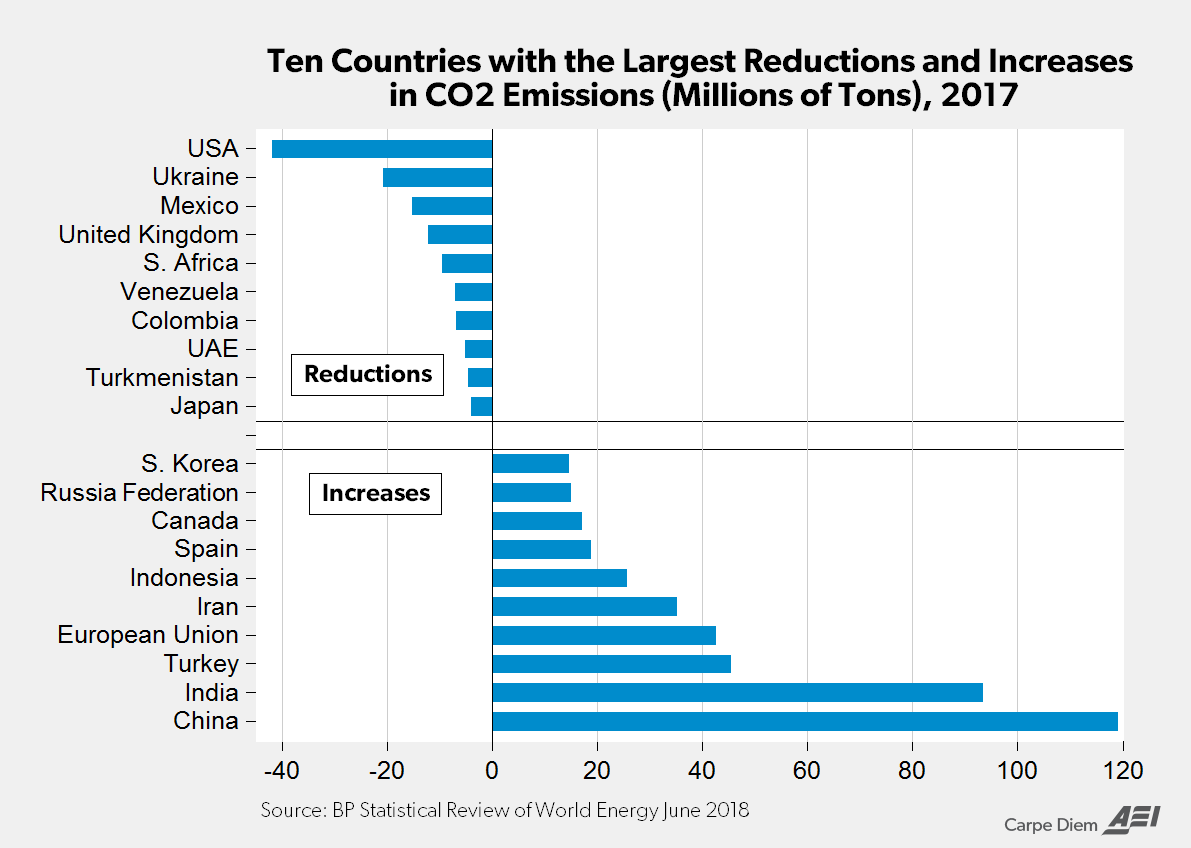Since the start of the 21st century, energy-based emissions have been falling dramatically in North Carolina.
- Carbon dioxide emissions are down 34 percent
- Nitrous oxides emissions are down 78 percent
- Sulfur dioxide emissions are down 91 percent
Why?
- As our state grows wealthier, we are transitioning from a manufacturing-based economy to a service-based economy
- As people grow wealthier, consumers are choosing more efficient products, from cars to appliances to electronics on down
- Electric utilities are moving to natural gas and away from coal, as technological revolution in the energy sector has made natural gas plentiful and price-competitive with coal
There’s no crisis here, there’s no market failure, and there’s no cause for alarm. These results are exemplary, and they are market-driven.

There simply is no call for government intervention here whatsoever. Which makes Gov. Roy Cooper’s Executive Order (EO) No. 80 to “Address Climate Change and Transition to a Clean Energy Economy” so unnecessary. The details of that EO don’t help.
Strangely, the governor justified the order by “citing Florence” and saying that his order would “combat climate change” which he linked to Hurricanes Matthew and Florence.
He also said the order would “create jobs.”
North Carolina can’t alter the world’s climate one bit
Before diving into the details, let’s look at the big picture first. The governor wishes to use executive authority to alter the climate. That is the stuff of comic books.
The State of North Carolina occupies an area that amounts to about 27 one-hundred-thousandths (0.00027) of the surface of the Earth. We could cease all productive activity and emissions and still have no impact on the planet. We could all disappear like the Lost Colony, and the global climate wouldn’t change.
The idea that we could save the climate by cutting our emissions reductions just a mite faster than we already have been doing for two decades is daft.
Furthermore, the State of North Carolina, as part of the United States of America, is leading the world in emissions reductions for the same market-driven factors listed above. True, the U.S. is not part of the Paris climate accords, which is supposedly another reason behind Cooper’s EO. But it is clear the U.S. is outperforming all the other nations who are.
Overall U.S. CO2 emissions are at their lowest level since 1992. U.S. CO2 emissions per capita are at their lowest level since 1950. So why should the governor act as if Paris matters?
Furthermore, many of the major players in the world aren’t just trailing the U.S. in emission reductions. They’re still increasing their emissions. Some by a tremendous amount. Look at China, look at India, and hello, look at the European Union.

Whatever reduction in emissions we make in the great State of 0.00027th of the Earth, they’re being obliterated immediately by those belching giants.
There can be no reasonable expectation of measurable climate impact from this EO. It is a futile gesture that seems more inspired by virtue-signaling, base-pandering, crony greasing, and PAC pleasing.
The governor can alter the state’s climate for cronyism, picking favorites, and wasting money
Now, the details. Here is what the EO seeks to do by 2025:
- Reduce greenhouse gas emissions to 40 percent below what they were in 2005
- Add 80,000 “zero-emission vehicles” (ZEVs)
- Cut energy usage per square foot in state-owned buildings by at least 40 percent below what they were, not in 2005, but in 2002-03
How would the governor accomplish these things? By incentives for certain goods and choices, expensive infrastructure build-ups, cronyism, euphemism, and make-work.
I also suspect a great deal of it is rooted in the hope of relying on continued market-driven progress from which he can later steal credit by dint of having dropped a toothless EO in the middle of all this ongoing improvement.
The incentives seem the logical result of such language as:
- having the Department of Environmental Quality make a “Clean Energy Plan” that “fosters and encourages” favored resources and “collaborate” with “interested stakeholders” over utilizing favored resources (note: “stakeholders” never, ever include the top stakeholders)
- having the Department of Commerce “take actions supporting” favored businesses and develop a “workforce assessment” to “recommend actions to help” favored industries
- having the Department of Transportation develop a plan specifically “designed to increase” ZEVs “to at least 80,000 by 2025,” a plan that includes incorporating “best practices for increasing ZEV adoption”
Among other things, this ZEV plan would also require building “interstate and intrastate ZEV corridors” and “ZEV infrastructure,” having state agencies “prioritize” purchasing or leasing ZEVs and use them for business travel, have state agencies build infrastructure necessary for ZEV use, and have state agencies develop “procurement options and strategies to increase the purchase and utilization of ZEVs.”
If you’re a manufacturer or lobbyist for electric vehicles, forget lottery fever; Gov. Cooper just flung the door wide open for government cronyism in your field. As Ed McMahon might say, You may already be a winner!
Cooper’s order also requires setting up new climate councils, agency climate managers, agency climate plans, meeting and reporting requirements, and a “Climate Risk Assessment and Resiliency Plan.” At best these could result in a lot of meaningless bureaucratic work.
That’s at best. My worry is they also harbor potential for a great deal of burdensome rulemaking mischief.


